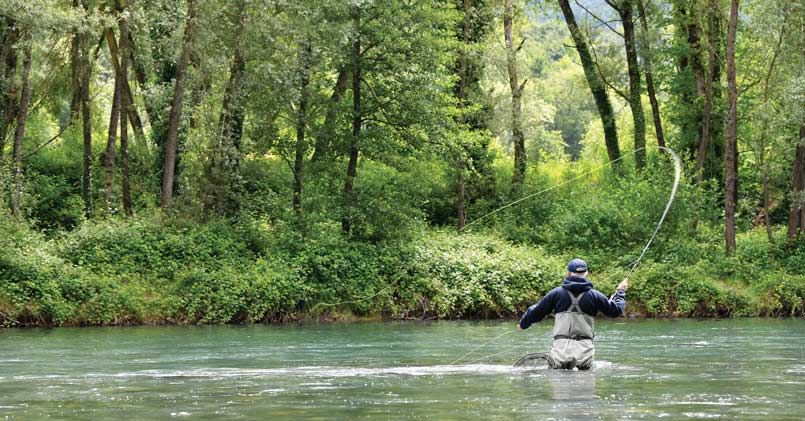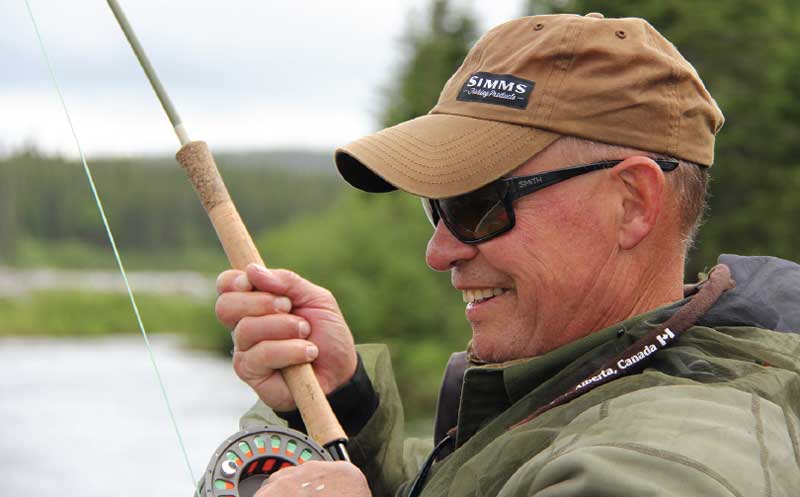

Eric Grinnell
Cold Creek Fly Fishers Club – Forty-five years of conservation, and a few fish tales
The Hendrickson mayflies are hatching, but the water temperature is below 12°C, so it’s a bittersweet April morning on Cold Creek in Orland. The trout are lethargic, disinterested in the humans gathering at the top of the creek bank. The fish wait patiently for the water to warm a few degrees before starting their own version of fly fishing.
This doesn’t deter the five dozen members of the Cold Creek Fly Fishers Club from gathering on opening day of trout season. They follow the rope railing guiding them to the shore that they continually remediate – adding shade and restoring native plants, installing small stones and larger boulders – to improve the fish habitat. They are conservationists first, fishers second.
Dave McLaren, who joined the group in 1978, knows this is routine. “Most of us don’t expect to have much luck fishing on opening day. It’s more social. We catch up, greet new members, talk about the creek, and maybe by afternoon the weather will cooperate, and we’ll catch something.” Any day on the water, he adds, is a day well spent.
With a strong club rule of catch-and-release, bragging rights are backed up only by trust and the odd smartphone photo, and even that is infrequent because members are also strongly encouraged to release the fish underwater, handling them as little as necessary to avoid harming protective scales. That’s okay, too, because these fly fishers have a lot of fish stories to share. Dave caught his first trout in 1955, and admits it is rare to see a 10-inch brook trout these days. “Since the mid-1990s, the brown trout population has decreased, as has the number of aquatic insects,” he notes. “It’s still good fishing.”
“ANGLING IS AN ART”
The simple art of gently casting into the water a concoction of feathers, hair and thread tied to a hook has remained the core of the complex sport of fly fishing since 1653, when Izaak Walton wrote in The Compleat Angler, “O sir, doubt not but that angling is an art. Is it not an art to deceive a trout with an artificial fly?”
Fly fishers can trace their roots to the British, who developed their art on famous streams like the Tweed, the Itchen and the River Test. Trout and salmon were considered the most desirable freshwater fish both because of their table qualities and their beauty.
In more recent times, fly fishing has experienced a growth in popularity, some of it attributed to the 1992 movie, A River Runs Through It, based on the novella of the same name by Norman Maclean. The lush photography, roaring mountain streams of Montana and stylized casting by the fisherman combined to create a rush of newcomers to the fly tackle shops.
The north shore of Lake Ontario is blessed with many small streams supporting populations of brook trout and brown trout as well as rainbow trout steelhead spawning runs. Smallmouth and largemouth bass can be easily caught on fly tackle, and there are some who pursue pike, muskie and even carp with the fly rod.
Many streams are in jeopardy, which places the fish habitat in equal peril, and that’s where the Cold Creek members really shine. Over the last 45 years, they have invested thousands of volunteer hours, tens of thousands of dollars, and decades of knowledge and hope.
MORE ABOUT DESTINY THAN DINNER
Founded in 1976 in Orland, the Cold Creek Fly Fishers Club has always been more about rehabilitating habitat than catching dinner, in large part because of the rare circumstances in which the club operates. “We’re one of the few fly fishing clubs with home waters,” explains Dave. “That makes conservation a huge focus for us because we know how fortunate we are to have this resource, so we honour and protect it.”
Those home waters came about through a lot of hard work. After a hundred years or more of homesteading, cattle grazing, land clearing and development, Cold Creek – like so many other waterways – was hurting. “In 1979, the shore was all marsh,” explains Dave McLaren. “Silt would wash down the gully into the stream and flood the gravel bed and kill the eggs.”
They sourced the best information from world renowned experts. “We learned techniques from river keepers in England. The river keepers on the River Itchen date back 400 years,” Dave notes. “They know how to do this and are willing to share their experience with like-minded organizations.”
“We built a wall and backfilled it with brush,” he continues. “That first year we picked rocks from fields and narrowed the stream. We had 125 tandem loads of boulders. Except for one, every single boulder was placed by us. We planted the dogwood and high bush cranberries and thousands of trees for overhanging cover.”
Agreements with landowners along Cold Creek help the club manage the stream, giving members exclusive access in exchange for stewardship. Club rules are observed by the members, who are often perplexed by poachers and trespassers who fail to respect signage and club rules about single barbless hooks and in-water catch-and-release. The Cold Creek Fly Fishers are dedicated to conservation and have a difficult time comprehending the actions of those who show disdain for the ethos and ecology of the club.
FRANK GOODRICH’S LEGACY
Efforts to help Cold Creek date back to 1935, when Frank Goodrich decided to stock a tributary. Goodrich researched the price of fingerlings, and found a hatchery just north of Toronto. He screened off a little pond on a tributary leading to Cold Creek behind the house on their family homestead. He removed all but the driver’s seat from their Model A Ford, set in three large milk cans, and went to get the fish.
His nine-year-old daughter Marjorie and her mother Eva ground liver, added milk and fed the mix to the fingerlings. Eventually Frank removed the screen and released the fish into the creek, but for years afterward some of them would return to that little spot.
The benevolence of waterside landowners remains integral to the success of the club’s conservation efforts. “John Seckar was the original landowner to let us fish and fix,” notes Brian Greck, a relatively new member, and a stream remediation expert. “He’s a true conservationist. He’s replanting his fields with willows and dogwoods to control the rate of erosion. The trees also provide nutrients from falling leaves and feed the insects. And when there are insects, there are fish.”
In his professional opinion (offered while holding his fly rod and looking very happy to be on the banks of Cold Creek), Brian recognizes the importance of these efforts. “Guests from the US and Britain are astounded at how lucky we are. This is probably one of the finest streams of its size in eastern Canada. It has the geology, soils, and water refreshed by the marsh at the Goodrich Loomis Conservation Area.”
Frank Goodrich’s fish – or at least their descendants – are still there. “These are resident fish; this is their home,” explains Sheldon Seale, a member of the Franklin Club 2016 Fly Fishing pro staff, and past president and director of the Izaak Walton Fly Fishing Club. After a lifetime of fishing, and 30 years of fly fishing, he admits it never stops being a challenge. “The learning curve starts vertical and stays that way. We’re always learning.”
CAST A LINE, LEARN A LOT
Fly fishing opens a window to the natural world of the stream or the lake and requires a certain involvement in the biology of the fish and its world. Learning the various types of insects and their stages and determining which of them the trout may be feeding on can be fascinating.
Fly rods and reels are the soul of simplicity. Basic equipment consists of a rod, usually graphite, about nine feet long, with a simple-action reel hung underneath. The reel is a drum that has no gearing – one revolution of the spool for each turn of the handle. The 100-foot line weighs enough to cast but is light enough to float. Between the line and the fly is a leader made of clear monofilament that tapers to a fine point at the end. The leader allows the fly to land gently on the water, well away from the splash of the line. A thinner, braided line called backing is attached to the back end of the fly line, filling the spool and allowing backup in case of fish needs to run farther than the 100 feet of the fly line available.
Before purchasing any equipment, it’s wise to seek advice from fly fishing specialty shops, fly fishing clubs and the many good books on fly fishing. Although a well executed cast with the long, light fly rod is an object of grace, what seems basic is far from it, and it’s a good idea for a newcomer to take a lesson to avoid learning bad habits.
Gary Allen, who acknowledges his obsession with a smile, is a 48-year Cold Creek veteran. He ties his own flies and understands the obstacles and the rewards. “It’s a game between us and the fish. We’re trying to imitate what the fish naturally eat, and sometimes we win. To catch a fish on a fly you tied on a rod you built is a big deal. Some people forge their own hooks and build their own reels. We gentlemen know how to waste time,” he smiles.
HEALTHY WATERS – HEALTHY WORLD
Year after year, more than 65 members of the club return to Cold Creek, casting a line in the water and helping to keep the waters healthy, confident their efforts are making a difference. Year after year, they share fish tales, and enjoy the art of fly fishing.
“Some of us are still wearing original hats,” boasts Dave, adding that they never tire of the pursuit. “The best time is when there’s a hatch on and you can hear it; the mosquitoes are eating your face off, the Muskol is blinding you, and you see the fish right in front of you.”
It’s easy to join Cold Creek Fly Fishers – a modest initiation fee and then annual renewals – and the rewards are the chance to spend a summer on a beautiful stream and the winter attending informative meetings. The club is welcoming, and the core belief is shared: “Fly fishing is a way of life based on conservation. Membership is open. Join us and learn, and be part of this,” suggests Dave.
A word of warning: think carefully before you stick a toe into fly fishing water. The venerable, revitalizing sport may carry you away and you may be hooked for life. www.coldcreekflyfishers.org
When I was a young boy, I was certain that I was going to be a trout fisherman and more specifically that I was going to fly fish for those trout. Those notions must have been born of a few trips with my father to the creeks that flowed into Lake Ontario to fish for what was called, at that time, speckled trout. I don’t recall ever catching a trout when I was a boy but I do recall misty mornings, watching my father endlessly casting his bamboo fly rod, whispers over the water and the glorious gulp when a trout took the fly. It must have been enough.
Over the many decades since those boyhood trips with my father, I have fly fished for trout across North America and have been fortunate enough to make a career of guiding fly fisherman for trout on famous western Canadian rivers, but my love of fishing came from my father and those speckled trout, those most beautiful of trout, caught in the sandy, cedar-shaded creeks of Northumberland County. Eric Grinnell
Story by:
Catherine Stutt

